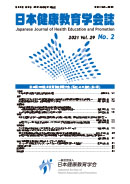Volume 29, Issue 2
Displaying 1-11 of 11 articles from this issue
- |<
- <
- 1
- >
- >|
Preface
-
2021 Volume 29 Issue 2 Pages 143-144
Published: May 31, 2021
Released on J-STAGE: June 16, 2021
Download PDF (182K)
Original Articles
-
2021 Volume 29 Issue 2 Pages 145-153
Published: May 31, 2021
Released on J-STAGE: June 16, 2021
Download PDF (442K) -
2021 Volume 29 Issue 2 Pages 154-162
Published: May 31, 2021
Released on J-STAGE: June 16, 2021
Download PDF (399K)
Field Reports
-
2021 Volume 29 Issue 2 Pages 163-172
Published: May 31, 2021
Released on J-STAGE: June 16, 2021
Download PDF (433K) -
2021 Volume 29 Issue 2 Pages 173-181
Published: May 31, 2021
Released on J-STAGE: June 16, 2021
Download PDF (430K)
Short Communications
-
2021 Volume 29 Issue 2 Pages 182-188
Published: May 31, 2021
Released on J-STAGE: June 16, 2021
Download PDF (374K) -
2021 Volume 29 Issue 2 Pages 189-197
Published: May 31, 2021
Released on J-STAGE: June 16, 2021
Download PDF (399K)
Special Report
-
2021 Volume 29 Issue 2 Pages 198-206
Published: May 31, 2021
Released on J-STAGE: June 16, 2021
Download PDF (442K)
Special Articles: Health education, health promotion, and COVID-19
-
2021 Volume 29 Issue 2 Pages 207-214
Published: May 31, 2021
Released on J-STAGE: June 16, 2021
Download PDF (853K) -
2021 Volume 29 Issue 2 Pages 215-222
Published: May 31, 2021
Released on J-STAGE: June 16, 2021
Download PDF (1145K)
Special Article: “Let's extend healthy life expectancy award“ by the MHLW: case report
-
2021 Volume 29 Issue 2 Pages 223-228
Published: May 31, 2021
Released on J-STAGE: June 16, 2021
Download PDF (737K)
- |<
- <
- 1
- >
- >|
